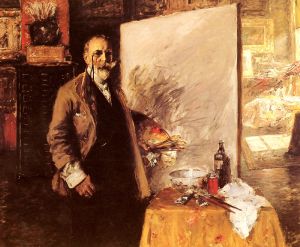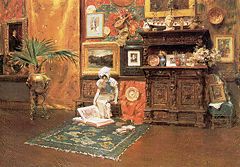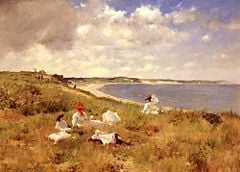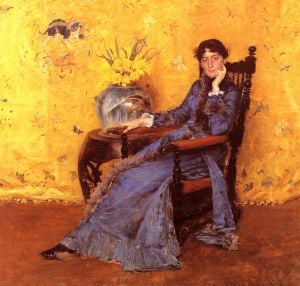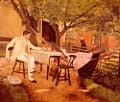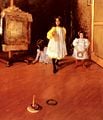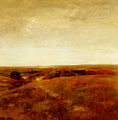Chase, William Merritt
| Line 2: | Line 2: | ||
{{Unreferenced|date=March 2007}} | {{Unreferenced|date=March 2007}} | ||
[[Image:Chase William Merritt Self Portrait 1915.jpg|thumb|left|300px|''Self Portrait'' (1915) from the collection of the [[Richmond Art Museum]], Richmond, Indiana]] | [[Image:Chase William Merritt Self Portrait 1915.jpg|thumb|left|300px|''Self Portrait'' (1915) from the collection of the [[Richmond Art Museum]], Richmond, Indiana]] | ||
| − | '''William Merritt Chase''' (November 1, 1849 – October 25, 1916) was an [[United States|American]] [[painter]] known as an exponent of [[Impressionism]] and as | + | '''William Merritt Chase''' (November 1, 1849 – October 25, 1916) was an [[United States|American]] [[painter]] known as an exponent of [[Impressionism]] and as one of the most prominent art teachers in America. His freely brushed canvases were reminiscent of both [[Édouard Manet]] and [[John Singer Sargent]]. |
== Biography == | == Biography == | ||
Revision as of 20:12, 30 September 2007
William Merritt Chase (November 1, 1849 – October 25, 1916) was an American painter known as an exponent of Impressionism and as one of the most prominent art teachers in America. His freely brushed canvases were reminiscent of both Édouard Manet and John Singer Sargent.
Biography
He was born in Williamsburg (now Nineveh), Indiana, to the family of a local merchant. Chase's father moved the family to Indianapolis in 1861 and employed his son as a salesman in the family business. Chase showed an early interest in art, and studied under local, self-taught artists Barton S. Hays and Jacob Cox.
After a brief stint in the Navy, Chase's teachers urged him to travel to New York to further his artistic training. He arrived in New York in 1869, met and studied with Joseph Oriel Eaton for a short time, then enrolled in the National Academy of Design under Lemuel Wilmarth, a student of the famous French artist Jean-Léon Gérôme.
In 1870 declining family fortunes forced Chase to leave New York for St. Louis, Missouri, where his family was then based. While he worked to help support his family he became active in the St. Louis art community, winning prizes for his paintings at a local exhibition. He also exhibited his first painting at the National Academy in 1871. Chase's talent elicited the interest of wealthy St. Louis collectors who arranged for him to visit Europe for two years, in exchange for paintings and Chase's help in securing European art for their collections.
In Europe Chase settled at the Academy of Fine Arts, Munich, a long-standing center of art training that was attracting increasing numbers of Americans. He studied under Alexander Von Wagner and Karl von Piloty, and befriended American artists Walter Shirlaw and Frank Duveneck. In Munich, Chase employed his rapidly burgeoning talent most often in figurative works that he painted in the loosely-brushed style popular with his instructors. One of these, a portrait titled "Keying Up" – The Court Jester (now in the collection of the Pennsylvania Academy of the Fine Arts) won a medal at the Philadelphia Centennial Exposition in 1876 and gained Chase his first fame.
Chase traveled to Venice, Italy in 1877 with Duveneck and John Henry Twachtman before returning to the United States in the summer of 1878, a highly skilled artist representing the new wave of European-educated American talent. Home in America, he exhibited his painting Ready for the Ride (collection of the Union League Club) with the newly-formed Society of American Artists in 1878. He also opened a studio in New York in the Tenth Street Studio Building, home to many of the important painters of the day. He was a member of the Tilers, a group of artists and authors, among whom were some of his notable friends: Winslow Homer, Arthur Quartley and Augustus Saint Gaudens.
Father, artist, teacher
Chase cultivated multiple personnae: sophisticated cosmopolitan, devoted family man, and esteemed teacher. Chase married Alice Gerson in 1886 and together they raised eight children during Chase's most energetic artistic period.
In New York City, however, Chase became known for a flamboyance that he flaunted in his dress, his manners, and most of all in his studio. At Tenth Street, Chase had moved into Albert Bierstadt's old studio and had decorated it as an extension of his own art. Chase filled the studio with lavish furniture, decorative objects, stuffed birds, oriental carpets, and exotic musical instruments. The studio served as a focal point for the sophisticated and fashionable members of the New York City art world of the late 19th century. By 1895 the cost of maintaining the studio, in addition to his other residences, forced Chase to close it and auction the contents.
In addition to his painting, Chase actively developed an interest in teaching. On the urging of a patron, Chase opened the Shinnecock Hills Summer School on eastern Long Island, New York in 1891 and taught there until 1902. Chase adopted the plein air method of painting, and often taught his students in outdoor classes. He also opened the Chase School of Art in 1896, which became the New York School of Art two years later with Chase staying on as instructor until 1907. Chase taught at the Pennsylvania Academy of the Fine Arts from 1896 to 1909; the Art Students League from 1878 to 1896 and again from 1907 to 1911; and the Brooklyn Art Association in 1887 and from 1891 to 1896. Along with Robert Henri, who became a rival instructor, Chase was the most important teacher of American artists around the turn of the 20th century. Beyond his instruction of East Coast artists, he had an important role in influencing California art at the turn of the century, especially in interactions with Arthur Frank Mathews, Xavier Martinez and Percy Gray.
Portrait painting
Chased worked in all media. He was most fluent in oil painting and pastel, but also created watercolor paintings and etchings. He is perhaps best known for his portraits, his sitters including some of the most important men and women of his time in addition to his own family. Chase often painted his wife Alice and their children, sometimes in individual portraits, and other times in scenes of domestic tranquility: at breakfast in their backyard, or relaxing at their summer home on Long Island, the children playing on the floor.
Landscapes
In addition to painting portraits and full-length figurative works, Chase began painting landscapes in earnest in the late 1880s. His interest in landscape art may have been spawned by the landmark New York exhibit of French impressionist works from Parisian dealer Durand-Ruel in 1886. Chase is best remembered for two series of landscape subjects, both painted in an impressionist manner. The first was his scenes of Prospect Park, Brooklyn and Central Park in New York; the second were his summer landscapes at Shinnecock. Chase usually featured people prominently in his landscapes. Often he depicted woman and children in leisurely poses, relaxing on a park bench, on the beach, or laying in the summer grass at Shinnecock. The Shinnecock works in particular have come to be thought of by art historians as particularly fine examples of American Impressionism.
Still lifes
Chase continued to paint still lifes as he had done since his student days. Decorative objects filled his studios and homes, and his interior figurative scenes frequently included still life images. Perhaps Chase's most famous still life subject was dead fish, which he liked to paint against dark backgrounds, limp on a plate as though fresh from a fishmonger's stall.
Honors and late career
Chase won many honors at home and abroad, was a member of the National Academy of Design, New York, and from 1885 to 1895 was president of the Society of American Artists. He became a member of the Ten American Painters after John Henry Twachtman died.
Chase's creativity declined in his later years, especially as modern art took hold in America, but he continued to paint and teach into the 1910s. One of his last teaching positions was at Carmel, California in the summer of 1914. Chase died on October 25, 1916 in his New York townhouse, an esteemed elder of the American art world. Today his works are in most major museums in the United States.
Works
Notes
ReferencesISBN links support NWE through referral fees
External links
- "William Merritt Chase: Modern American Landscapes, 1886-1890". Traditional Fine Arts Organization. Retrieved September 1, 2007.
- Pioch, Nicolas. 2002. "Chase, William Merritt". WebMuseum. Retrieved September 1, 2007.
- "William Merritt Chase". ArtCyclopedia. Retrieved September 1, 2007.
Credits
New World Encyclopedia writers and editors rewrote and completed the Wikipedia article in accordance with New World Encyclopedia standards. This article abides by terms of the Creative Commons CC-by-sa 3.0 License (CC-by-sa), which may be used and disseminated with proper attribution. Credit is due under the terms of this license that can reference both the New World Encyclopedia contributors and the selfless volunteer contributors of the Wikimedia Foundation. To cite this article click here for a list of acceptable citing formats.The history of earlier contributions by wikipedians is accessible to researchers here:
The history of this article since it was imported to New World Encyclopedia:
Note: Some restrictions may apply to use of individual images which are separately licensed.
